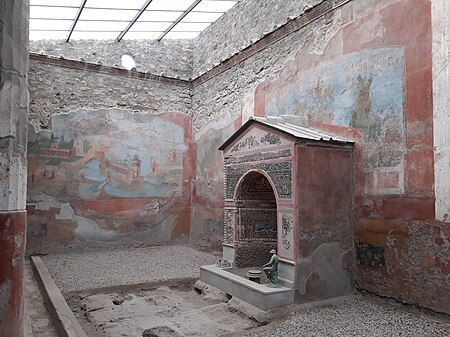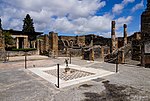House of the Small Fountain

The House of the Small Fountain (Casa della Fontana Piccola, VI.8.23), aka House of the Second Fountain or House of the Landscapes, is located in the Roman city of Pompeii and, with the rest of Pompeii, was preserved by the eruption of Mount Vesuvius in or after October 79 CE. It is located on the Via di Mercurio, a street running north from the Arch of Caligula, at its crossroads with Via delle Terme, and Via della Fortuna, to Pompeii's fortification tower XI in the northwest part of the city. The street is named after a public fountain at VI.8.24 with a relief of the god, Mercury. Insula 8 is on the west side of the street. The house is named after a mosaic fountain adorned with shells at the rear of its peristyle. The property is immediately adjacent to The House of the Large Fountain (VI 8,22,1), a structure with an even larger mosaic fountain adorned with shells and marble sculptures of theatrical masks excavated earlier in 1826. So the size difference between the fountains was used to distinguish the two structures.
Excerpt from the Wikipedia article House of the Small Fountain (License: CC BY-SA 3.0, Authors, Images).House of the Small Fountain
Viale Giuseppe Mazzini,
Geographical coordinates (GPS) Address Nearby Places Show on map
Geographical coordinates (GPS)
| Latitude | Longitude |
|---|---|
| N 40.751429 ° | E 14.483645 ° |
Address
Scavi archeologici di Pompei
Viale Giuseppe Mazzini
80045
Campania, Italy
Open on Google Maps











